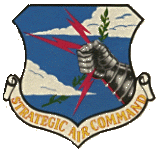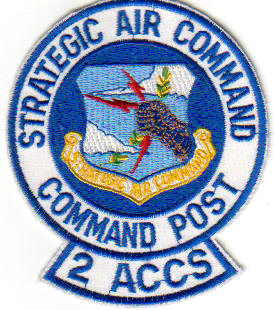The need for a survivable SAC Command Post as a key component of adequate U.S. deterrence and security meshed well with the change in U.S. nuclear policy from massive retaliation to flexible response and its focus upon control of America's nuclear strike force during the trans- and early post-SIOP periods. The one likely survivable candidate was an airborne platform, and plans had been under consideration by SAC since late 1958 to test an airborne command post variant of the KC-135, with a desired operational capability by 1960.

On May 26, 1960, the first KC-135A (58-0022) began modification to an airborne command post configuration, and operational tests started two months later at Offutt AFB, Nebraska. Five modified KC-135As assigned to the 34th AREFS were placed on ground alert and periodically tested to determine their ability to take off within 15 minutes. Once airborne, they would serve as an alternate command post, assuming primary control over the SAC combat force if (or, more appropriately, when) an enemy attack destroyed the underground facility at Offutt AFB and the other NAF command posts. On board each flight was a senior SAC officer (initially a colonel and eventually a general) - known as the Airborne Emergency Action Officer (AEAO) - who would take over command of the SIOP forces in the event communications were lost with the NCA and SAC headquarters.
After six months the test was deemed a success, hailed by CINCSAC General Thomas S. Power as 'conclusive proof" of the effectiveness of an airborne command post, and a decision was made to expand the program. Additional KC-135As were converted into airborne command posts for use as back-ups to the primary airborne command post.
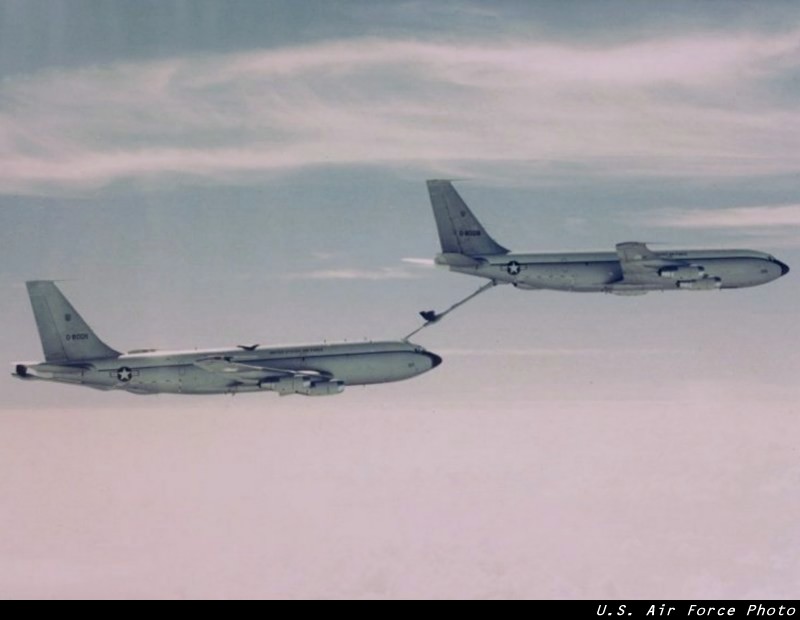
In Jan of 1960, President Kennedy directed that one of SAC's new airborne command posts to be airborne at all times, and, on 3rd February 1961, the KC-135 Looking Glass Airborne Command Post (ABNCP) began continuous airborne operations, with additional back-up airplanes on 15-minute ground alert. The KC-135 airborne command post sortie - dubbed the "Looking Glass" - was airborne safely and continuously from 3rd February 1961, to 24th July 1990.
During 1962 SAC's Post Attack Command and Control System (PACCS) underwent the first of several major reorganizations, expanding to include three KC-135A auxiliary airborne command post (AUXCP) units and four support squadrons. Beginning in April 1962 AUXCPs were assigned to tanker squadrons based at NAF headquarters of the 2nd AF at Barksdale AFB (913th AREFS, 2nd BW), the 8th AF at Westover AFB (99th AFRES, 22nd BW). The AUXCPs were configured the same as the primary airborne command post and could replace it if and when needed. SAC organized four support squadrons at Mountain Home AFB, Idaho, Lincoln AFB, Nebraska, Lockbourne AFB, Ohio, and Plattsburgh AFB, New York, on 20th July 1962, all equipped with Boeing EB-47L radio relay platforms.
To reflect more properly the 'electronic' mission of the airborne command posts and to distinguish them from tankers, on 1st January 1965, all dedicated airplanes not already identified as such were redesignated with an 'EC' prefix: thus KC-135As became EC-135As and the KC-135Bs became EC-135Cs.
PACCS underwent another major reorganization on 25th March 1965. The EB-47L units at Lockbourne AFB and Mountain Home AFB were inactivated (EB-47L units at Lincoln AFB and Plattsburgh AFB had already been inactivated) and their radio-relay missions absorbed by EC-135As assigned to the 32nd AREFS, 301st AREFW at Lockbourne AFB and the 28th AREFS, 28th BW at Ellsworth AFB, South Dakota, respectively. PACCS was now exclusively EC-135A and EC-135C equipped. So the Looking Glass, AUXCPs, and the radio-relay aircraft made up the PACCS.
Looking Glass = SAC ABNCP
Auxiliary Command Post = AUXCP
RR = Radio-Relay

Also in 1965, theater commanders who controlled nuclear weapons acquired airborne command posts to improve the post-strike controllability of their nuclear forces. Unlike the 'Looking Glass', the theater airborne command posts were on ground alert and their battle staffs were commanded by a colonel or navy captain, with sufficient warning, a flag officer was added to the battle staff.
Commander-in-Chief, Europe = 'Silk Purse'
Commander-in-Chief, Pacific = 'Blue Eagle'
Command-in-Chief, Atlantic = 'Scope Light'
The value of the EC-135 airborne command post as survivable platforms capable of directing retaliatory strikes against the Soviet Union was powerfully demonstrated on 17th April 1967, when an airborne battle staff successfully launched a Minuteman II ICBM from Vandenberg AFB after receiving 'the necessary launch signal'. Only SAC airborne launch platforms - 'Looking Glass' and AUXCP EC-135Cs - and the newly modified Airborne Launch Control Center (ALCC) EC-135As and EC-135Gs, had an airborne launch control system (ALCS) installed. The ALCS, which achieved its initial operational capability on 31st May 1967, was operated by a SAC missile crew flying aboard the airplane and incorporated the same safeguards against accidental launch as in ground control centers.
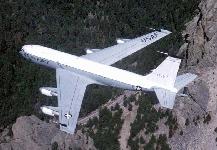
On 1st April 1970, SAC underwent a major reorganization that completely altered the PACCS structure but not its mission: the 'Looking Glass' continued 24-hour airborne alert and the AUXCPs, ALCCs, and radio-relay airplanes remained on 15 minute ground alert. Air refueling and strategic reconnaissance squadrons that had operated PACCS aircraft were relieved of this responsibility and the airplanes and crews assigned to newly formed Airborne Command and Control Squadrons (ACCS). The 38th SRS, 55th SRW at Offutt AFB, the 305th AREFS, 305 AREFW at Grissom AFB, and the 28th AREFS, 28th BW at Ellsworth AFB, transferred their EC-135Cs and crews to the 2nd ACCS, 55th SRW at Offutt AFB, the 3rd ACCS, 305th AREFW at Grissom AFB, and the 4th ACCS, 28th BW at Ellsworth AFB, respectively.
The 2nd ACCS was responsible for the EC-135C 'Looking Glass' primary airborne command posts and EC-135C MIDAUXCPs (know by its static call sign of 'Achieve'). The MIDAUXCP also provided a survivable battle staff suite for CINCSAC, provided there was sufficient warning time for him to arrive at the aircraft prior to its alert launch.
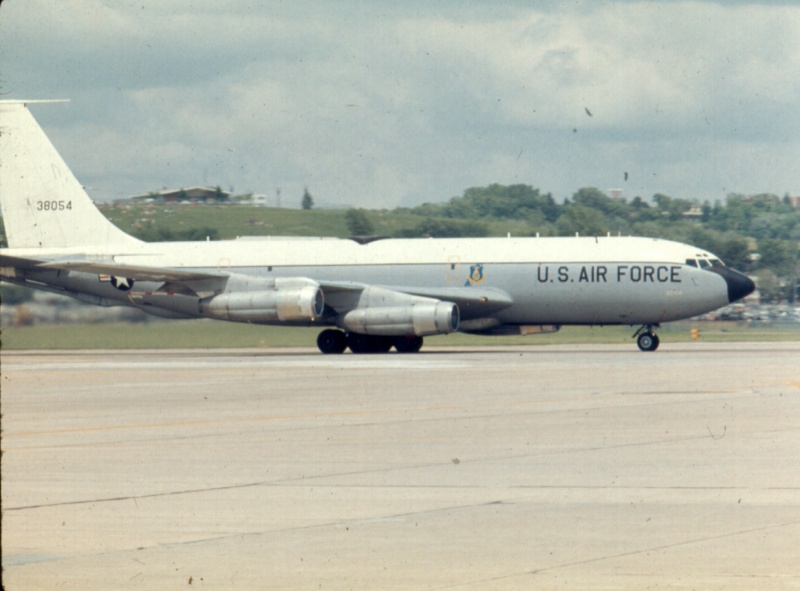
The 3rd ACCS supported EC-135C EASTAUXCP and EC-135L radio-relay platforms. In addition to its role as a back-up to the 'Looking Glass', the EASTAUXCP provided a secondary source of secure communications with the National Command Authority to the east of Offutt AFB and the 'Looking Glass'. Both the EASTAUXCP and radio-relays sat alert at Grissom AFB and at Lockbourne AFB (later renamed Rickenbacker ANGB).
The 4th ACCS operated the WESTAUXCP and the ALCCs. The WESTAUXCP - typically an EC-135C, but occasionally an EC-135G with attendant mission degrade - provided a secure radio link between the 'Looking Glass' and the two or three airborne ALCCs, which orbited above the Minuteman 'missile fields' in the Dakotas, Wyoming, Nebraska, Colorado, and Montana. One ALCC sat alert alongside the WESTAUXCP at Ellsworth, and two ALCCs sat alert at Minot AFB.
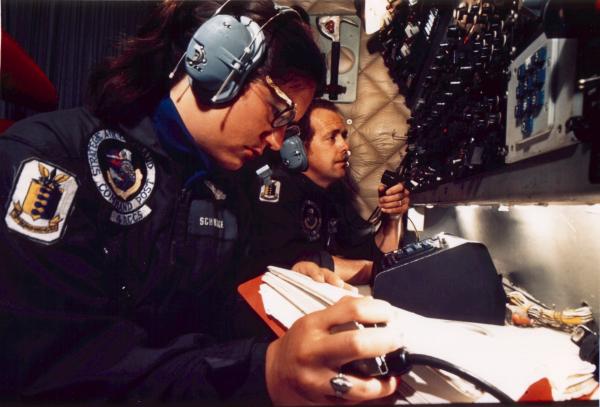
The PACCS reorganized again in 1974, seeing the standup of the 6th ACCS, 4500th ABW at Langley AFB with the EC-135Ps formed Command-in-Chief, Atlantic = 'Scope Light' airborne command post. 'Blue Eagle', Command-in-Chief, Pacific, was named the 9th ACCS. The 3rd ACCS was inactivated on 31st December 1975. Its radio relay functions were assumed by the 70th AREFS, 305th AREFW at Grissom AFB, and its EASTAUXCP duties by the 2nd ACCS at Offutt AFB.
For the next 15 years, SAC's airborne command post fleet remained constant in numbers, mission, and organization. Centered around a EC-135C 'Looking Glass' operated by the 2nd ACCS, the PACCS fleet included two AUXCPs (one from the 2nd ACCS - the EASTAUXCP - and one from the 4th ACCS - the WESTAUXCP) on 15 minute ground alert. The 4th ACCS provided ALCCs No. 1, 2 and 3, and the 70th AREFS supported Radio Relays No. 1 and 2. The ALCCs and the WESTAUXCP were on satellite alert at Minot AFB, and Radio Relay No. 2 was on alert at Rickenbacker ANGB, Ohio (formerly Lockbourne AFB).
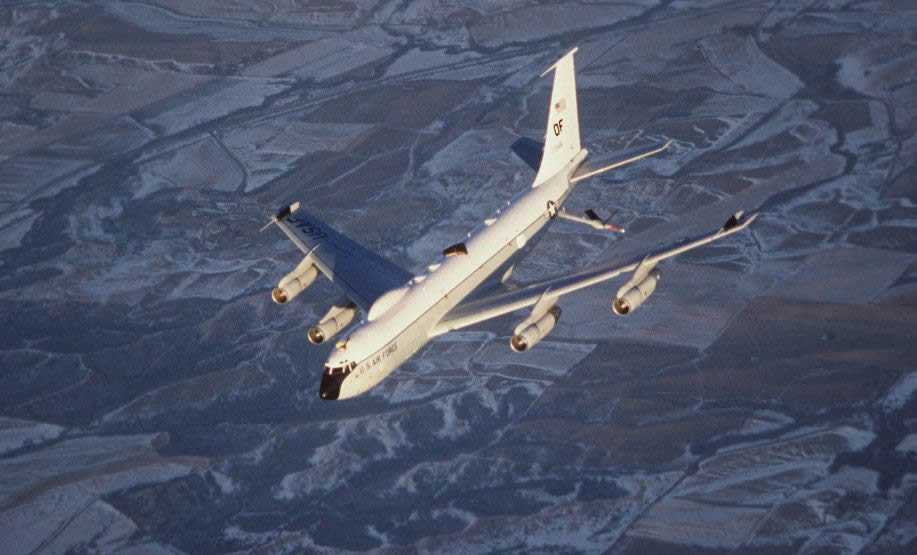
In the event of a national emergency, the 'Looking Glass' and the two AUXCPs would orbit over the central US, the three ALCCs would orbit above the Minuteman missile fields in the north central and northwest US, and the two radio relay platforms would orbit over the Midwest, establishing and maintaining communications links with the National Command Authority airborne over the east coast.
Should communications be lost with the NCA or the SAC underground command post, the 'Looking Glass' battle staff would, after satisfying a strict set of guidelines regarding taking over from civilian command of US SIOP Forces, 'assess battle damage, communications, radioactive fallout, and the location and strength of surviving forces'. The 'Looking Glass' battle staff would also 'plan and coordinate strategic strikes against enemy targets and direct returning aircraft to bases with safe runways and plenty of fuel'. If need be, 'the battle staff could launch the entire force of Minuteman and Peacekeeper missile'.
